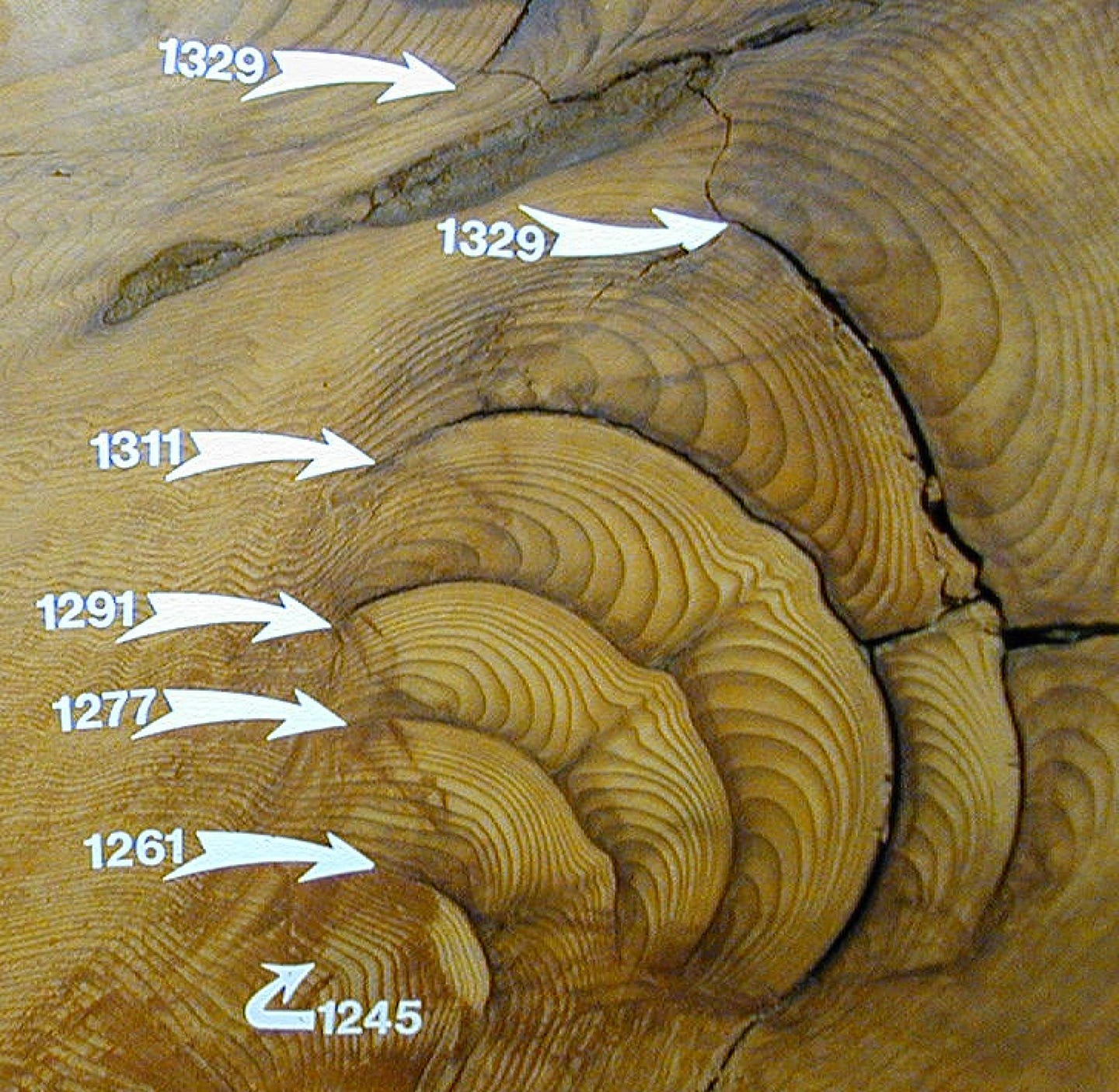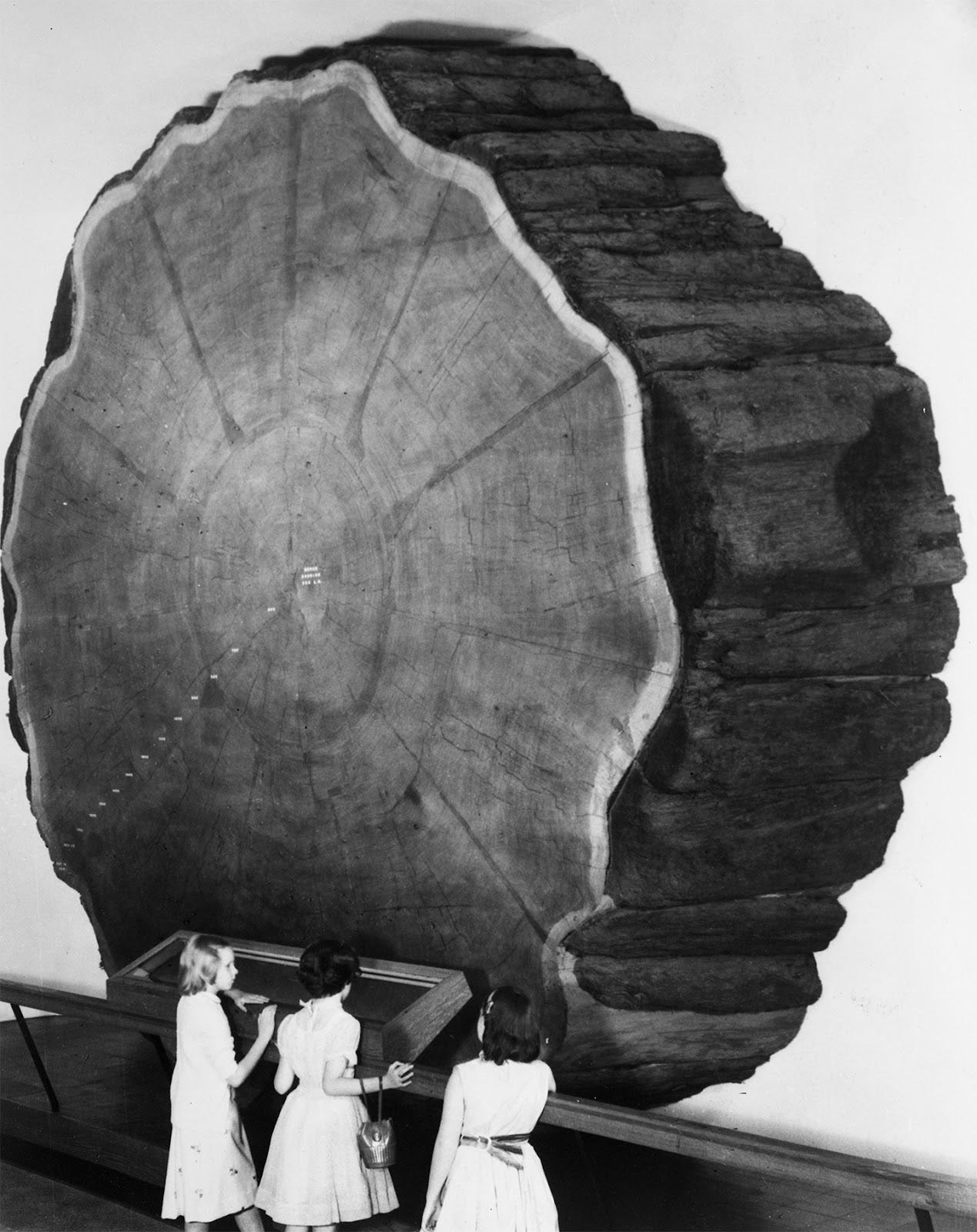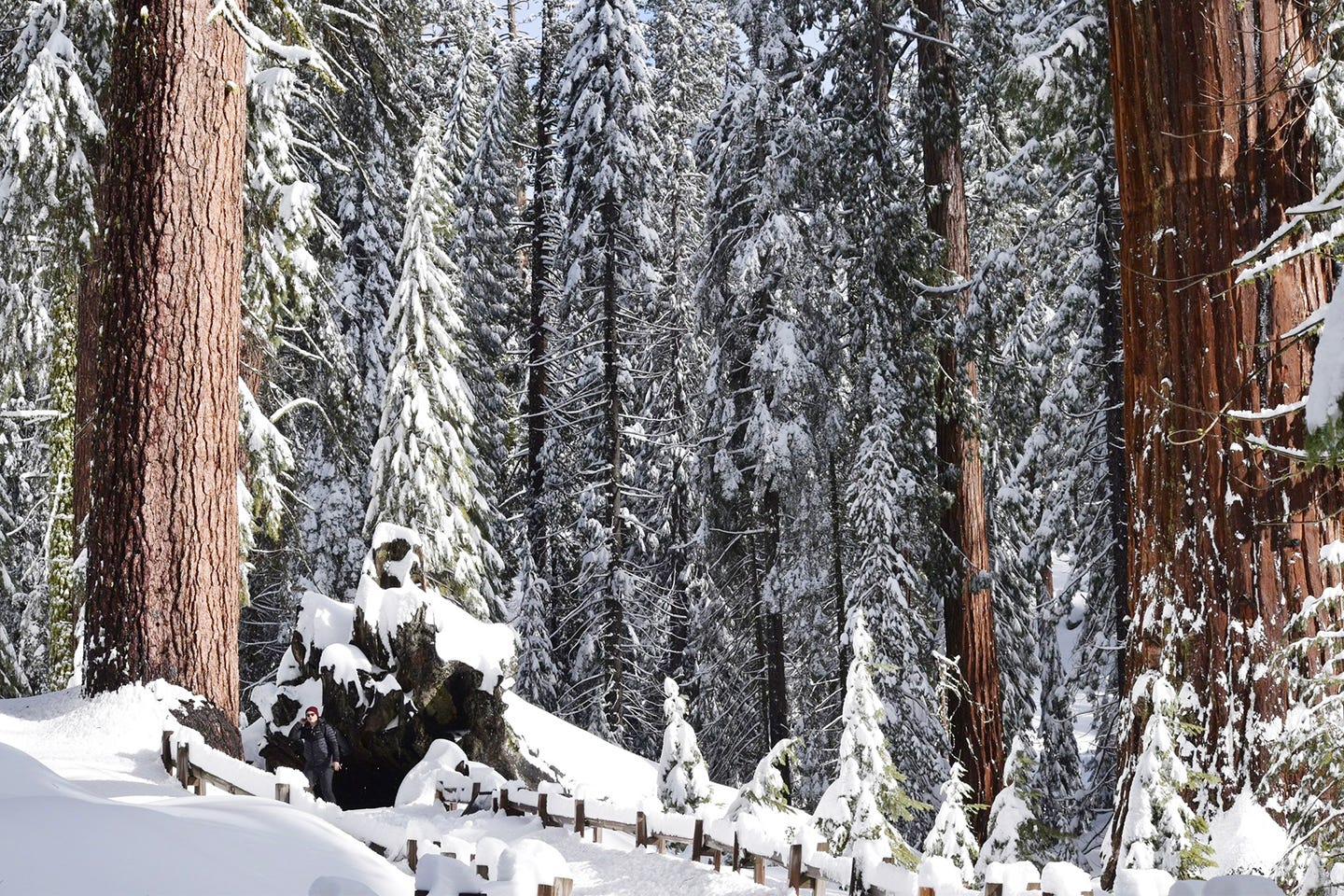What can giant sequoias tell us about climate?
A good question as ‘atmospheric rivers’ continue to pound California
Volume 1, Number 36 - Monday, March 20, 2023 - Welcome spring!
Now twice a week — Monday and Thursday mornings!

Perspective
PEOPLE HAVE LIVED in the Sierra Nevada for at least 10,000 years. The earliest rainfall records from Southern California date from around 1769, but such data in the Sierra Nevada wasn’t recorded until much later.
In a summary written for Giant Sequoia National Monument by Hugh Safford, regional ecologist, USDA Forest Service, Pacific Southwest Region, in 2010, two long-term precipitation datasets are mentioned. One is from Huntington Lake at an elevation of 7,020 in Sierra National Forest and the other is from Grant Grove station in Sequoia-Kings Canyon National Parks, about 80 crow miles to the north at an elevation of 6,850 feet.
Records at Huntington Lake date from 1915 and those from Grant Grove start in 1921. Safford also references two other weather stations in Sequoia National Park that do not go back as far.
My point is that rainfall and temperature records kept by people are relatively new. To learn more about the climate of the past — which may help us see where our climate is going — scientists look to other clues and tree rings of giant sequoias are among them.
Tree rings are important data banks and the study of tree rings is called dendrochronology.
This article (GIFT LINK) in the New York Times, provides great background and also explains that research involving tree rings is “divided into three main categories — dendroclimatology, the analysis of tree rings for past climate data; dendroarchaeology, the study of tree rings to understand how past climate affected human societies; and dendroecology, which reconstructs past forest ecosystems.”
Among relevant findings:
• A 3,000-year record from 52 of the world's oldest trees shows that California's western Sierra Nevada was droughty and often fiery from 800 to 1300, University of Arizona researchers reported in 2010 (HERE).
• From this 1992 study: The period from roughly 1850 to 1950 had one of the lowest frequencies of drought of any one hundred year period in the 2089 year record. The 20th century (as of 1992) has had a below-average frequency of extreme droughts.
• From the 2019 NYT article referenced above: “Researchers can also look at snowpack in tree ring records. In 2015, in the Sierras the snowpack was the lowest in 500 years. This year (2019) may be one of the highest snowpacks in decades, a testament perhaps to climate whiplash. Researchers here are reconstructing snowpack data by examining tree ring records across the entire western United States for the last 2,000 years.”
Of course, now in 2023 we have further evidence of the “climate whiplash.” Not much more than a year ago, as described in this article in the Mercury News, we were in drought. Now we have a record snowpack and flooding so severe that water is flowing into the old Tulare Lake. And the “atmospheric rivers” we’ve been experiencing — they’re not new. Check out THIS article from 2013 about the “coming megafloods” and you’ll learn about the storms from the Pacific that pounded California for 43 days in 1861, bankrupting the state.
On Facebook yesterday, I saw a meme posted by a group called “The California Water for Food and People Movement.” It said: “Fun Fact — 3 of the last 7 years have broken rain and snowfall records.” #ManMadeDrought.
I’m all for water for food and people, but I don’t think we do ourselves any favors thinking that we can gauge California’s climate by looking at any particular 7-year history. If there is anything that remains the same about our climate here is that it’s variable.
As the storms continue this week, I hope you stay safe and dry! — Claudia Elliott
Life in ‘an accidental igloo’
Here’s an excerpt from a post on SEKI’s Facebook page on March 16 from a ranger only identified as Joseph (who I suspect may be Joseph Norvalis who took the great photo of Grant Grove shown above):
“I thought you might like to hear about what it's been like living in the park this winter!
I came to California from Northeastern Pennsylvania, where I had experience camping in sub-zero temperatures and working outside in whiteout conditions — I thought I knew all about winter. A year ago, I moved across the country to work at Kings Canyon National Park. Little did I know I'd be present for some of the most extreme winter weather in California history!
“A major factor in this experience is remoteness. This goes with the territory of living in most national parks! From where I live in Grant Grove, it takes two hours each way to get groceries in the summer, when road conditions are good. In winter, it can be an all-day affair, involving tire chains, coolers filled with snow, and road conditions that require skilled, careful driving. It’s common to go a month between restocks.
“Furthermore, power outages are common during winter storms. An outage that might last an hour or two in town could take a week to fix here, hours away from crews that can help. This is where candlelight and wood stoves come in!
2023 thus far has also battered us with major storms, cold and warm. The cold storms brought snow, snow, and more snow, that gradually buried our homes and offices to the eaves — and then more snow. Living in such an accidental igloo is a neat idea, but as our muscles ache from shoveling our front doors clear over and over again, the novelty begins to wear off.
“The warmer storms have resulted in numerous mud and rock slides. These are even more likely to occur because so many slopes in the parks are denuded of vegetation, a lingering effect of the massive 2021 KNP Complex Fire. When these slides hit park roads, they leave park residents without access to the outside world, sometimes for weeks at a time. We love being here, but not having the ability to get out is hard on us.
“So, despite all this, why do I want to be up here? The short answer is, it emerges from love. I love being tasked with protecting the largest living trees on earth. I love being a steward of some of the most extensive and glorious wilderness areas of our country. And I love to serve the public by facilitating amazing experiences in these places I love so much — yet another reason I am looking forward to restored access to the parks!”
Wildfire, water & weather update
Writing for the Hanford Sentinel on March 15, John Lindt noted that the southern Sierra has the biggest snowpack ever. And that was before this week’s storms. Read his article HERE.
An excerpt: “The southern Sierra now has the largest snowpack in recorded history (as measured by snow water equivalent). Not just for March 15, but at any time.
“As of Wednesday, the snowpack is 271% of normal and 260% of April 1 average.The Kings River Water Association confirms that is likely true for the upper Kings watershed as well.”
The best information on what is heading toward the Sierra Nevada can be found at NWS Hanford, HERE, and NWS Sacramento, HERE.
Drought update: Last Thursday’s California drought map is here. For this year, at least, the drought is over where giant sequoias grow (although the impact of the last two droughts is still a consideration).
Wildfire update: Likewise, no wildfires in the Sierra Nevada. But here’s an interesting article that says that severe summer wildfires (in previous years) are impacting the western U.S. mountain snowpack. It’s worth a read HERE.
Did you know you can comment here?
It’s easy to comment on items in this newsletter. Just scroll down and you’ll find a comment box. You’re invited to join the conversation!
The difference between the Monday and Thursday editions
Monday’s editions of the newsletter include my ramblings about giant sequoias and related topics under the heading “Perspective,” in addition to the historic photo of the week and featured giant sequoias growing outside their natural range (around the world).
Thursday editions typically will include more formal articles (long form journalism). Both editions have links to news about giant sequoias and weather and wildfire updates, depending on the season. And additional features will be added to Thursday’s edition.
Subscriptions to the Monday newsletter remain free. Beginning this week, access to the Thursday editions and archives will require a subscription.
Giant Sequoia News is now on Facebook
Consider following (or liking) Giant Sequoia News on Facebook for occasional updates in between newsletters. CLICK HERE to find us.
Giant sequoias in the news
• As reported in the Plumas News, Representatives Doug LaMalfa (R – CA) and Jimmy Panetta (D – CA) introduced the Forest Protection and Wildland Firefighter Safety Act of 2023 on March 14. The bill creates a Clean Water Act exemption for federal, state, local, and tribal firefighting agencies to use fire retardant to fight wildfires. Read more HERE and also on my favorite blog, The Smokey Wire, HERE.
Here’s an excerpt from the articles:
This bill is being introduced because an environmental group is suing the Forest Service under the Clean Water Act to require a NPDES permit to use fire retardant, and they have requested an injunction on the use of fire retardant until the Forest Service receives this permit, which could take years. If the injunction is granted and fire retardant is not available for use in the 2023 fire year, firefighters and individuals living in forested areas would be in peril, millions of acres of forested land would be in danger, and billions of dollars of infrastructure would be at risk.
• Oregon Public Broadcasting’s take on the so-called “zombie trees” of the Sierra Nevada is HERE.
• High Country News had an interesting article last Friday about the atmospheric rivers that brought so much water to California. Read it HERE.
And an excerpt:
Why did California see so many atmospheric rivers this year?
While the causes and impacts of this year’s storms will be studied for years to come, weather experts say that they follow what climate change models have predicted for years. Warmer air holds more moisture — about 7% more for every 1.8 degrees Fahrenheit (1 degree Celsius) — so as ocean and air temperatures rise, storms become more potent.
One hallmark of climate change is the simultaneous appearance of drier droughts and wetter storms – what climatologists call weather “whiplash.” “I know this is a surprise to a lot of folks, but that’s going to be driven primarily by the wet side more than the dry side,” said UCLA climatologist Daniel Swain on his Weather West Youtube channel. “The wets will become even wetter than the dries will become drier.” Storms will get much more intense, even as the West is wracked with drought.
Historic photo of the week

My guess is that this photo is from the late 1950s or early 1960s, judging by the girls’ outfits. Here’s a LINK to the museum’s page about the slab (or slice) which it states was felled by loggers in 1891. The display doesn’t seem to have changed at all.
Giant sequoias around the world
I happened upon another amazing place where giant sequoias grow in Ireland — the Giants Grove, said to be the largest grove of giant redwoods outside California — on the grounds of Birr Castle (about a two-hour drive west of Dublin). Read more HERE.
Especially interesting is an article on the project’s website about managing expectations. Here’s an excerpt:
“Perhaps the most difficult challenge in managing the Giants Grove is managing people’s expectations. The name conjures up images of massive trees, impressive heights, and inspiring girths – a grove of giant trees. It will be all those things, but not for decades. Every iconic redwood in their true home, Sequoia National Park, California, began as a little sapling like those in the Giants Grove. They suffered drought, fire, deer, and frost, but they have seen and survived it all.”
Thanks for reading!




